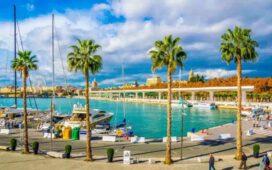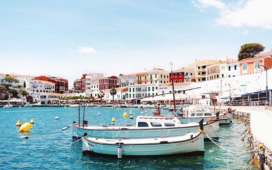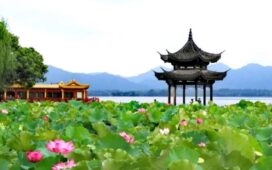As the largest district in East Java Province, Banyuwangi is currently one of the most popular tourist destinations. Did you know that this city, which is located on the eastern tip of the island of Java, has a million charms that are extraordintiful?
Most visitors who come just pass before crossing to the Island of the Gods are directly adjacent to the Bali Strait. But if you have time, try to stop for a moment and explore this small town nicknamed The Sunrise of Java. The area is diverse, ranging from lowlands to highlands, mountainous and coastal regions, historical locations, and other ancient heritage sites.
For those of you who want to explore the city of Banyuwangi, here is a list of exciting tourist attractions to visit.
- Ijen Crater Banyuwangi
Since being designated a biosphere reserve area by UNESCO in 2016, Kawah Ijen Banyuwangi has become increasingly popular among local and foreign tourists. Still included in the Ijen Tourism Park area with 2,560 hectares, this tourist attraction is located at the top of Mount Ijen in Licin District, Banyuwangi.
One of the most dangerous tourist attractions in the world occupies the largest caldera on the island of Java which was formed by the eruption of Mount Ijen with a width of 6 meters and a depth of 200 meters. Called dangerous because the turquoise blue crater water has near-zero acidity.
However, the natural scenery in Ijen Crater is the main attraction for visitors who come. There is a blue fire phenomenon that appears at the sulfur mining location only at 05.00 WIB. You can watch the beauty of the sunrise, whose light reflects on the surface of the water, giving rise to beautiful colors. In addition, the panorama of the splendor of Mount Merapi, Mount Raung, Mount Rante, and others can be seen from Ijen Crater. To get there, you have to climb for approximately 2-3 hours from Paltuding.
- Blambangan Park
Banyuwangi Blambangan Park was originally a city square that was later developed as a Green Open Space (RTH) by the local government. The park, which is also often called Gesibu Blambangan Park, has 32,000 m2 with neatly arranged trees.
You could say this tourist attrac a place of recreation for residents. Here, visitors will find various sports facilities such as a running track, basketball court, and skateboard area. On weekends, you will find many local residents gathering and interacting at Blambangan Park. Meanwhile, every Saturday night, visitors will be treated to dance performances typical of Banyuwangi. There is also a variety of food sold to accompany a relaxing time. Visitors who want to enjoy the atmosphere of Banyuwangi City from here do not need to pay any fees, or it is free.
- Blambangan Temple
Judging from its history, Pura Agung Blambangan is a historic site from the Blambangan Kingdom in the Alas Purwo area, South Banyuwangi. This temple has a Hindu style which is a magnet for religious tourism for certain tourists. Located in Tambak Rejo Village, Muncar District, Pura Agung Blambangan is one of the main holy places for Hindus in Indonesia. Not only from Java but many visitors also come from the island of Bali when the Kuningan holiday arrives.
Foreign tourists also often visit Pura Agung Blambangan because they are interested in the structure of the building. This temple is the second largest after Gunung Salak Temple and among 92 other temples in Banyuwangi. When visiting the temple, you must wear a scarf to respect local customs and culture.
- Sidodadi Glenmore Reservoir
One of the newest tourist attractions in Banyuwangi is Sidodadi Glenmore Reservoir. Only opened to the public in 2015 and inaugurated in 2016, this reservoir was previously built to irrigate sugarcane plantations. However, the potential of the natural beauty around it is not wasted by the local government, who then turns it into a cheap tourist location.
Located in Karangharjo, Glenmore, Sidodadi Reservoir has more than 6 hectares and will continue to be developed into 10 hectares. Access to the location is also not so difficult, with good road conditions and close to the main Banyuwangi-Pacitan route.
Here, visitors can do various interesting activities, such as hanging slides along the 160 meters across the reservoir, renting an ATV, boating, or challenging sports on the motor circuit. Not only that, but this tourist spot also has a beautiful flower garden, fruit garden, fishing pond, and camp area.
Visitors who come only need to pay a parking ticket of Rp. 2,000 to Rp. 5,000. If you want to try out various existing rides, the rates are set at various rates, ranging from Rp. 10,000 to Rp. 25,000 per vehicle.
- Banyuwangi Osing Tourism Village
Local people are more familiar with the name Kemiren Village, but this village is better known to tourists as Osing or Using Village. Located only about 15 minutes from downtown Banyuwangi, Osing Village is a tourist destination that is worth a visit because of its strong cultural nuance.
In the Osing Village area, the main attraction is the Genjah Arum Studio with the arrangement of ancient Osing houses that are more than 100 years old. Visitors can learn about the history of the tribe from the shape of the house. There are four traditional houses with different shapes that indicate the social status of the residents, namely Crocogan, Tikelbalung, Tikel, and Serangan.
Also, at the Genjah Arum Studio, you can see firsthand the culture and customs of the original Osing tribe. There is an angklung paglak that farmers often play while guarding their rice fields. There is also the Barong Kemireng dance and the Gandrung dance, which are performed when welcoming guests. Even more interesting, visitors can listen to Other or lesung music played by middle-aged women from the Osing tribe. This music is played by playing a pestle and mortar accompanied by music from angklung paglak and drums.
- The Great Temple of Gumuk Kancil
According to the story, the Great Temple of Gumuk Kancil was intended as a tribute to Rsi Markandeya, a spiritual figure of Hinduism in the 7th century AD. Not only people who are Hindus, but general tourists also often visit this tourist spot.
Located in Bumiharjo Village, Glenmore District, the Great Temple of Gumuk Kancil stands right on the edge of the forest and has cultural heritage status. Not far from the temple complex, there is Beji Spring, which the local community believes tincturing various diseases. This tourist attraction can be accessed quickly, and visitors do not have to pay an entrance ticket.
Ready to start your getaway to Banyuwangi? Visit Wonderful Indonesia, and don’t miss out on the magic!













